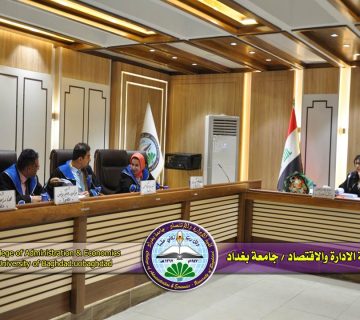The College of Administration and Economics at the University of Baghdad discussed, a PhD dissertation in field of Statistics by the student (Elaf baha alwan ) and tagged with (Estimating A Semi-Parametric Fuzzy Quantile Regression Model with Application ) , Under supervision of (Prof. Dr. Omar Abdulmohsin Ali )
Fuzzy regression is considered one of the most important regression models, and recently the fuzzy regression model has become a powerful tool for conducting statistical operations, however, the above model also faces some problems and violations, including (when the data is skewed, or no-normal, …..) and thus leads to incorrect results, so it is necessary to find a model to deal with such violations and problems suffered by the regular fuzzy regression models and at the same time be more powerful and immune than the fuzzy regression model called the semi-parametric fuzzy quantile regression. This model is characterized by containing two parts, the first is the fuzzy parametric part (fuzzy inputs and crisp parameters) and the second is the fuzzy nonparametric part for fuzzy triangular numbers, and the semi-parametric fuzzy quantile regression is estimated in two stages:
First: Using the (Hessamian and Akbari) method, the fuzzy non-parametric part is estimated based on weights and some kernel functions (Gaussian, Epanechnikov, Triangle) and then the fuzzy outputs are estimated,
Second: Using a new distance measure (Jensen–Shannon Divergence Distance) (JS) based on fuzzy belonging functions. It was also suggested to estimate the non-parametric part by (SVM), and then propose the complex model that combines (FSPQR) (non-parametric SVR model) as in Equation (2.117).
To apply the effectiveness of the proposed models, this is done through (simulation study, and practical application). The application of data simulation is studied using the (python program) by applying different sample sizes (fuzzy inputs and outputs and real parameters) to the models mentioned in Chapter Two. The performance is evaluated based on different kernel functions (Gaussian, Epanechnikov, and Triangular) and different sample sizes.
The researcher concluded through the results and when comparing the (Akbari and Hasmayan) distance measure and the proposed distance measure (JS), the researcher concluded that the proposed distance measure is more reasonable and takes less time to reach the results
i.e. fewer iterations compared to the (AK) measure, which indicates faster convergence.
On the other hand, the simulation results presented in Chapter 3 show that the Fuzzy Support Vector Regression Model (FSVRM) shows stable performance across different sample sizes. The coefficient W and bias B remain constant, indicating that the model parameters are reliable. The left and right limits of the Fuzzy number LR (lB and rB) are adjusted according to the sample size, reflecting the model’s improved ability to accommodate data variance. The mean squared (MSM) and generalization metric (G1) measures show good accuracy and generalization, with only slight increases in error as the sample size grows. These results suggest that (FSVRM) is a robust model for prediction tasks, and handles different data sizes effectively.
The triangle kernel consistently provides the best performance in terms of both MSM and G1 across different smoothing parameters. This trend is observed across different sample sizes, indicating the strength of the triangle kernel in accurately modeling underlying data patterns.
The fuzzy support vector regression model (FSVR) shows superior performance. The G1 value of (FSVR) is significantly higher than that of both FQRM and FSPQRM, reflecting better generalization and accuracy. This makes FSVR the most effective model for capturing data patterns and providing robust predictions among those discussed. In summary, while FSPQRM with the triangle kernel provides the best G1 value, the FSVR model stands out with the highest G1 value overall, indicating superior generalization and accuracy. The effectiveness of each model varies based on specific performance metrics, highlighting the importance of choosing the right model based on the needs of the application.










